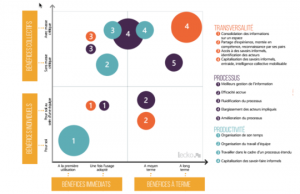If you are spearheading the launch of a corporate social network within your organization with the goal of creating a collaborative workspace for everyone, we recommend that you start with a few groups (for the duration of the pilot phase) and proceed gradually with the implementation.
Start by identifying the groups who experience serious issues regarding communication as well as with the sharing of information and documents, and who broadly demonstrate issues with “working as a group” on a daily basis. They may be people who are geographically distant, people who have to work with external partners, groups in which there is significant mobility… They may simply be people who have to exchange content regularly and who have reached the limits of what emailing (or mailing lists) permits to correctly perform the tasks.
Identify the first groups to be formed as well as the team or group leaders according to the nature of the groups.
For each group, identify their needs, the issues they face, what will be valuable to them, the goals to be achieved (see our previous article regarding the best practices for launching a group).
Avoid beginning with groups whose benefits are collective and require a critical mass of members. Start in a simpler fashion with groups who are focused on the immediate resolution of problems encountered by employees in their daily work, and where the contribution of a collaborative platform will be easily observable. If there is a real benefit for users to use the platform as a new tool, then you won’t need to entice them and they will discover the other groups that will be created over time and to which they will be able to contribute.
Start with the uses associated with “immediate benefits/individual and collective” that are directly involved with the daily workflow (see the diagram below from “CSR Volume 8” study published by Lecko in 2016) :
- Transversality: individual – consolidation of informations within a space, collective – access to informal knowledge, identification of participants
- Processes: individual – better management of information, collective – streamline the processes, larger number of participants involved
- Productivity: individual – personal time management, collective – organization of teamwork, working within an extended process.

______
This article is part of a series focusing on to the best practices to be adopted for the launch and implementation of a collaborative platform or private social network within a company or organisation.



![[Expert Opinion] Steps for Achieving a Successful HR Transformation](https://blog.talkspirit.com/wp-content/uploads/2024/02/Achieving-HR-transformation-400x250.jpg)